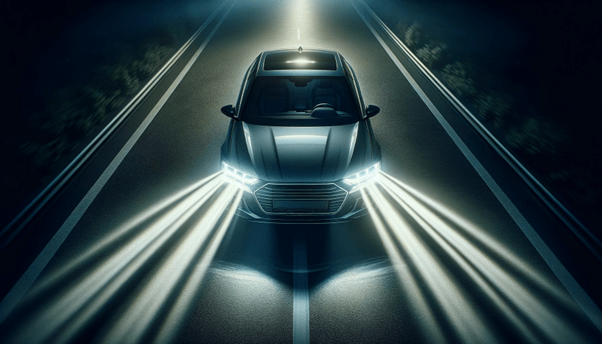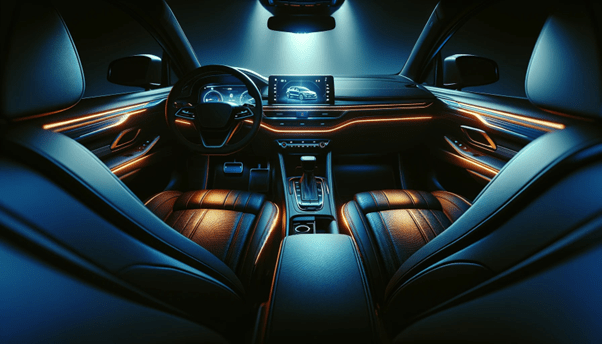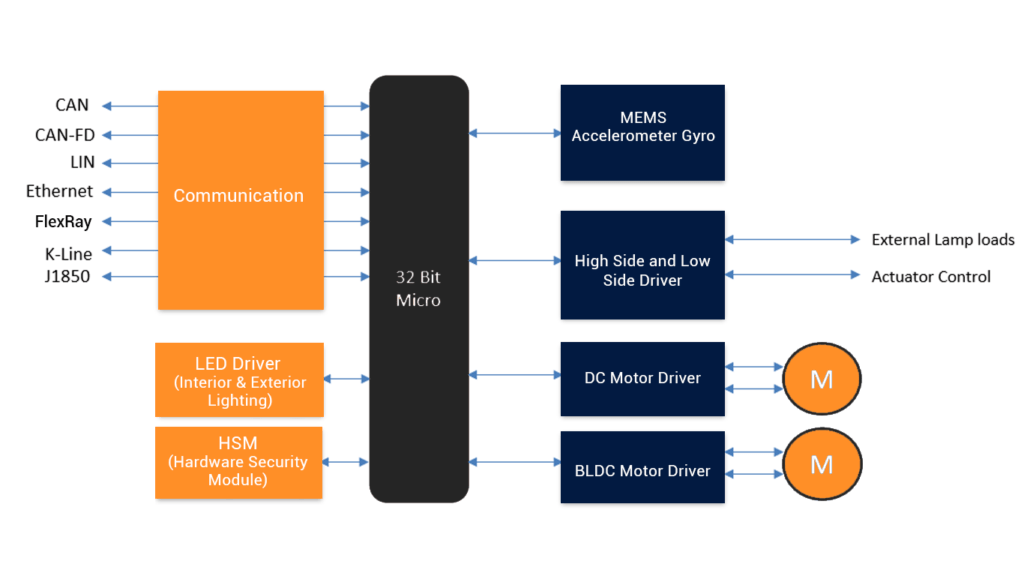The integration of advanced lighting in vehicles marks a revolutionary stride in automotive innovation. Automotive lighting solutions have transcended their traditional role of illumination. Today, automotive lighting is a cornerstone of vehicular safety, aesthetics, and a catalyst for enhancing user interaction.
Imagine adaptive front-lighting systems that intelligently align with road curves, offering drivers visibility and security on the road. These advancements aim at reducing potential hazards associated with challenging driving conditions.

Beyond safety, the utility of automotive lighting becomes evident in autonomous vehicles, particularly with the integration of interior lighting systems. These systems are designed to respond and adapt to the passengers' needs.
For instance, in an autonomous vehicle, interior lighting can be employed to signal important stages of the journey, such as approaching a destination, or to indicate the necessity for a human driver's intervention. Such interventions ensure that the transition between automated and manual control is smooth and clearly communicated.
Moreover, the application of lighting in vehicles extends to improving driver wellness and comfort. Ambient lighting within the car's cabin can be adjusted to reduce fatigue on long journeys or to create an environment conducive to relaxation or alertness, depending on the driver's needs. This focus on the driver’s psychological and physical well-being is a testament to the holistic approach automakers are adopting.
Recent Applications of Modern Automotive Lighting Solutions in Different Categories
- • Applications in Passenger Cars
- Adaptive Headlights: These automatically adjust the direction and intensity of the headlight beams based on the vehicle's speed, road conditions, and steering angle. For instance, BMW's Adaptive Headlights system illuminates the road according to the car's movements.
- Ambient Lighting: Many luxury vehicles now feature customizable ambient lighting options, enhancing in-cabin aesthetics. Mercedes-Benz, for instance, offers 64-color ambient lighting in some of its models.
• Lighting Solutions in Commercial Vehicles
- LED Bar Lights: Commercial trucks and trailers are now using LED bar lights for better visibility during nighttime, especially when transporting goods over long distances.
- Emergency Flash Systems: For vehicles like ambulances, modern lighting solutions have introduced more intense and visible emergency flashes, ensuring they're noticed even in heavy traffic.

Development of Control System for Automotive Lighting Solutions
Automotive lighting control systems have evolved significantly with the advancement of electronics and computing power within vehicles. These systems manage everything from simple on/off functions of traditional headlights to the sophisticated adaptive light controls in modern cars. Here's an elaborate breakdown:
Application Layer: At the top level, the application layer provides the user interface and decision-making logic.
- User Interface (UI): This includes dashboard switches, touch screen interfaces, and voice command systems. For instance, a driver can choose different lighting modes (automatic, parking, headlights, high beam) via the UI.
Decision Logic: Based on inputs from various sensors and the UI, this layer decides how lights should behave. For example, in automatic mode, the algorithm may be configured to switch on headlights based on ambient light conditions.
Middleware: It serves as a bridge between the application layer and the lower-level hardware interfaces and device drivers.
- Communication Protocols: Most cars use protocols like CAN (Controller Area Network) or LIN (Local Interconnect Network) for intra-vehicle communication. This middleware ensures the high-level commands get translated into the appropriate protocol messages.
Device Drivers: These are software components that facilitate communication between the operating system and the hardware. In the context of automotive lighting:
- PWM Drivers: Pulse Width Modulation (PWM) drivers control the intensity of lights. For example, controlling the brightness of interior ambient lighting.
ADC Drivers: Analog-to-Digital Converter (ADC) drivers may be used to interpret signals from ambient light sensors.
Control Hardware: This hardware layer interprets signals from the higher software layers and translates them into electrical controls for the lighting.
Microcontrollers are the small computers on chips that process inputs and outputs for the lighting system. They interpret the CAN or LIN messages and decide how to drive the lights accordingly.High-Side and Low-Side Drivers:
- High-Side Drivers: They switch the positive side (usually the battery voltage) to the load (like a bulb or LED). High-side drivers are commonly used when the load (light in this case) needs to be connected to the ground permanently, which is often the case in automotive systems to ensure safety.
- Low-Side Drivers: They switch the ground side of the load. They're often simpler and cheaper but might not be suitable for all automotive applications.
Actuators & Sensors:
- Lighting Actuators: These include the actual lights – LEDs, halogen bulbs, HID lamps, etc.
- Sensors: Various sensors feed data into the control system. Common sensors in lighting systems include:
- • Ambient Light Sensors: Determine the light levels outside the car.
- • Rain Sensors: Some systems adjust lighting based on weather conditions.
Feedback Mechanism: For advanced systems, feedback is crucial. If a light isn't functioning (e.g., a bulb is out), the system needs to know.
- Diagnostics and Monitoring: The system continuously checks the status of each light and can notify the driver if there's a malfunction.
Now, its time to explore the importance of advanced lighting in the realm of autonomous vehicles.

Ambient Lighting in Autonomous Vehicles: A Decade of Progress
As the automotive world races towards a future punctuated by autonomous vehicles (AVs), an often-overlooked aspect is the role of interior lighting. While it might seem like a mere aesthetic component, the last decade has revealed its significance in ensuring safety, enhancing experience, and managing human-machine interactions.
Lighting Application Inside Autonomous Vehicles:
As autonomous vehicles (AVs) continue to evolve, so does the sophistication and purpose of their interior lighting systems. Here, we dissect various applications of lighting in AVs, demonstrating how they're more than just ambient beautification tools—they're integral for safety, user experience, and human-machine interaction.
The control system for automotive lighting is a sophisticated combination of software and hardware, ensuring that the vehicle's lighting responds appropriately to both the driver's commands and environmental conditions. As vehicles move towards greater autonomy, these systems will likely become even more intricate, enhancing safety, and driving experience.
The Role of Ambient Lighting in Safety
According to the World Health Organization's 2018 road safety report, around 1.35 million individuals tragically lose their lives in road accidents annually. The allure of a fully autonomous vehicle, where every aspect, including the interior environment, works in harmony, promises to reduce these grim statistics.
However, as we navigate the transition phase of mixed driving ranging from manual (Level 0) to fully automated (Level 5) as defined by the Society of Automation and Engineering (SAE)—the responsibilities of drivers in semi-automated vehicles (Levels 2 to 4) remain pivotal. In these vehicles, drivers must constantly monitor the system and be ready to take control.
It's in this scenario that ambient lighting becomes a vital safety feature. For example, during instances when a driver is distracted or engaged in Non-Driving Related Tasks (NDRTs), the vehicle's lighting system can use Take Over Requests (TORs) to redirect the driver's attention. These TORs might use varying modalities—from visual cues to auditory alerts—to ensure immediate human intervention when required.
A. Take-over Request (TORs) Take-over requests, often termed as TORs, act as modalities to keep the driver engaged, alert, and promptly respond to driving tasks, especially after distractions. For instance, one of the studied modalities involves visual interruption. Here, notifications are sent to the driver's mobile phone or in-vehicle display, serving as a cue for the driver to focus back on driving.
Though this method has shown some efficacy, mobile-based TORs might not always yield the highest performance. Another innovation entails luminance signals in the peripheral view that immediately alerts the driver during critical situations of Advanced Driving Assistance Systems . This method keeps the driver's eyes glued to the road and mitigates distractions.
• Multi-modal based TORs: Evidence from various studies suggests that multi-modal TOR interfaces, which combine different alert methods, are often more effective than uni-modal setups. For instance, one such study investigated multiple NDRTs, such as phone conversations, smartphone interaction, and video watching. It was found that multi-modal visual-based interactions outperformed their uni-modal counterparts in terms of reaction time and time to collision. Another area of focus is on tasks like document handling while driving. It's observed that drivers often prioritize higher importance tasks, sidelining less urgent ones.
B. Perception of Speed Understanding and perceiving speed is crucial for safe driving. Some intriguing innovations revolve around the use of interior light stripes mounted at specific locations, such as the A-pillar of the vehicle. This not only allows the driver to gauge speed through visual cues but also offers insights into safe speed ranges. Another noteworthy development involves the use of an RGB array of LED lights on the dashboard, which provides alerts during emergencies, potentially preventing road mishaps.
C. Perception of Ambient Lighting Ambient lighting within AVs isn't just about creating a pleasant environment; it's also about perception and safety. Various studies have analyzed different vehicle lighting scenarios, concluding that even peripheral lighting can significantly impact perceptions of safety, space, and attractiveness. Research also delves into the best locations for such lights. Surveys indicate a preference for dashboard lighting, shedding light (pun intended) on optimizing interior design for maximum efficacy and appeal [35].
D. Lane Change Decisions Lane changes in AVs, especially levels 2 and 3, aren't just about mechanical precision but also about driver awareness. A novel approach involves the use of a peripheral LED strip on vehicle doors, providing constant feedback about road conditions, aiding in determining safe lane changes. Such systems have shown to elicit quick and accurate decisions from drivers, especially when they're contemplating turning off the autopilot for faster lanes. In this context, the side-door lights significantly reduce cognitive load, making lane-changing safer and more efficient.
Conclusion
The journey towards fully autonomous vehicles is a complex one, with myriad components needing to work in perfect synchronization. As we've seen over the last decade, the role of automotive lighting has evolved from being a mere functional feature to a critical component in safety and user experience.
As the development of smart, intelligent, and innovative transportation systems continues, the in-depth understanding and integration of effective in-vehicle lighting systems will undoubtedly steer us towards a brighter, safer future on the roads.

